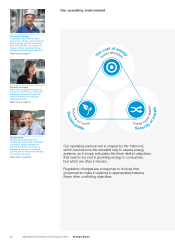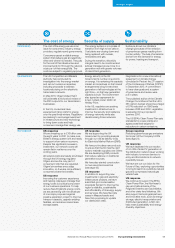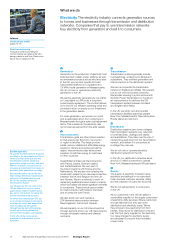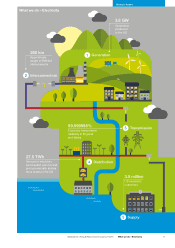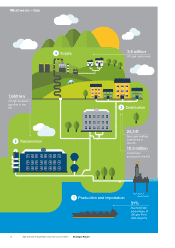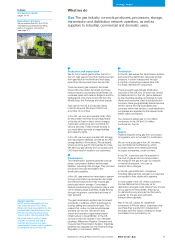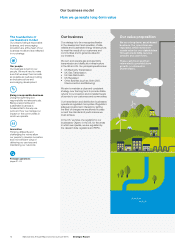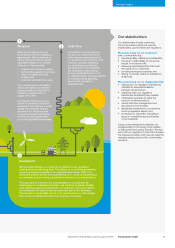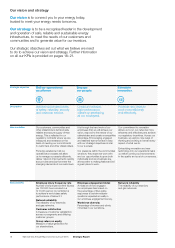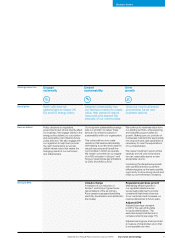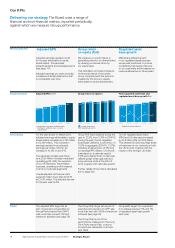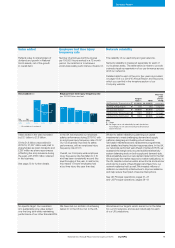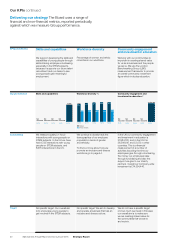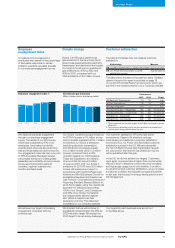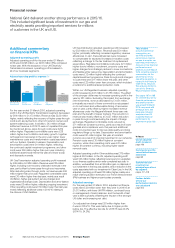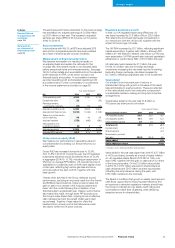National Grid 2016 Annual Report Download - page 15
Download and view the complete annual report
Please find page 15 of the 2016 National Grid annual report below. You can navigate through the pages in the report by either clicking on the pages listed below, or by using the keyword search tool below to find specific information within the annual report.
What we do
Gas The gas industry connects producers, processors, storage,
transmission and distribution network operators, as well as
suppliers to industrial, commercial and domestic users.
In focus
Our business model
pages 14–15
Biomethane milestone
We connected the UK’s first 100%
renewable biomethane HGV filling
station in Leyland, Lancashire
(see page 37).
System operator
As SO we are responsible for the
high pressure gas NTS in Great
Britain. We have responsibility for the
residual balancing activities on the
NTS and for keeping the physical
system within safe operating limits.
Our price control, set by Ofgem,
includes incentives that aim to
maintain and improve our daily
operational efciency and are subject
to renegotiation at set intervals.
3
Distribution
In the UK, gas leaves the transmission system
and enters the distribution networks at high
pressure. It is then transported through
a number of reducing pressure tiers until
it is finally delivered to consumers.
There are eight regional gas distribution
networks in the UK, four of which are owned
by National Grid. In the US, gas is delivered
by the interstate pipeline companies to local
distribution networks. Each local distribution
company has a geographically defined service
territory and is the only local distribution
company within that territory. Local distribution
companies are regulated by the relevant local
state’s utility commission.
Our networks deliver gas to 10.9 million
consumers in the UK and 3.6 million
customers in the US.
4
Supply
Pipeline shippers bring gas from producers
to suppliers, who in turn sell it to customers.
We do not supply gas in the UK. However,
we own National Grid Metering, which
provides meters and metering services
to supply companies, under contract.
In the UK, customers pay the supplier for
the cost of gas and for its transportation.
We transport the gas through our network
on behalf of shippers, who pay us
transportation charges.
In the US, gas distribution companies,
including National Grid, sell gas to consumers
connected to their distribution systems.
In most cases in the US, where customers
choose National Grid, they pay us for
distribution and gas costs. Where they choose
to buy gas from third parties, they pay us
for distribution only and pay the third-party
supplier for the gas and upstream
transportation capacity.
Also in the US, except for residential
consumers in Rhode Island, customers may
purchase their supply from independent
providers with the option of billing for those
purchases to be provided by us.
1
Production and importation
We do not produce gas in either the UK or
the US. Gas used in the UK is mainly sourced
from gas fields in the North and Irish seas,
piped from Europe and imported as LNG.
There are seven gas reception terminals,
three LNG importation terminals and three
interconnectors connecting Great Britain via
undersea pipes with Ireland, Belgium and the
Netherlands. Importers bring LNG from the
Middle East, the Americas and other places.
Gas used in the US is produced mainly
in North America. We import LNG from
a number of countries.
In the UK, we own and operate Grain LNG,
an importation terminal and storage facility
at the Isle of Grain in Kent, which charges
customers under long-term contracts for
various services. These include access to
our importation terminal, storage facilities
and capacity rights.
In the US, we own and operate LNG storage
and vaporisation facilities, as well as an LNG
storage facility in Providence, Rhode Island,
where we store gas for third parties for a fee.
We also buy gas directly from producers and
LNG importers for resale to our customers.
2
Transmission
The transmission systems generally include
pipes, compressor stations and storage
facilities, including LNG storage. They connect
production through terminals to the
distribution systems.
In the UK, gas enters the transmission system
through importation and reception terminals
and interconnectors and may include gas
previously held in storage. Compressor
stations located along the network play a vital
role in keeping large quantities of gas flowing
through the system, particularly at times of
high demand.
The gas transmission system has to be kept
constantly in balance, which is achieved by
buying, selling and using stored gas. This
means that, under normal circumstances,
demand can be met. We are the sole
owner and operator of gas transmission
infrastructure in Great Britain. In the US,
we hold a minority interest in two interstate
pipelines: Millennium Pipeline Company and
Iroquois Gas Transmission System. Interstate
pipelines are regulated by the Federal Energy
Regulatory Commission (FERC).
13National Grid Annual Report and Accounts 2015/16
Strategic Report
What we do – Gas







